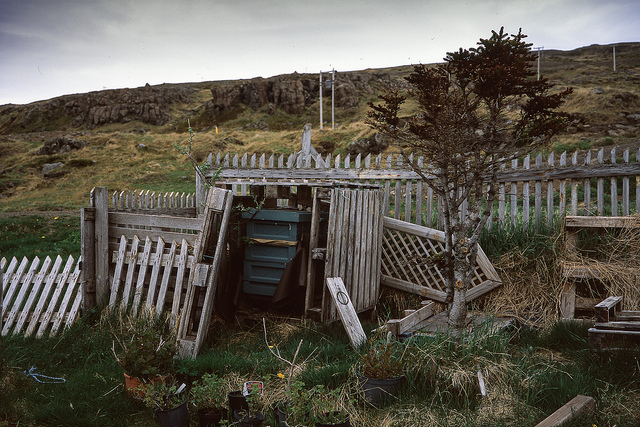
[Pat’s Apiary, Westfjords Iceland 2016.]
Beekeeping on Iceland is challenging. The hive above, on Pat’s farm in the Westfjords, is barely surviving, which still is an achievement. The hive below, in Drangsnes, also in the Westfjords, didn’t make it through the winter.

[Sigrún’s Apiary, Westfjords Iceland 2016.]
It’s not uncommon that colonies die already in their first year, but in many parts of Iceland it seems like it’s almost impossible to make honey bees thrive for longer periods. The weather is just too harsh and there’s not enough flowering plants. Around these two hives there’s not even heather. Feeding the bees with more sugar could make up for the lack of flowers, but if all the bees eat is imported sugar then the question is if it wouldn’t be better to just import honey instead.
In other parts of Iceland, where the climate is milder, beekeeping is working out better, but it’s still challenging. People on Iceland have been attempting beekeeping with more or less success from at least the 1940’s, but more organised beekeeping didn’t start until the late 1990’s. Today the Icelandic Bee Association keeps track of 100-150 hives on Iceland. There are beekeepers who get up to 60kg of honey from a hive which is a good harvest, and there’s even a beekeeper who has started to breed queens.
But Iceland is still dependant on importing bees. The bees are imported from Åland, an island in the Baltic sea, between Sweden and Finland. Åland has been lucky and, because of its relative isolation, not been subjected to varroa and other bee diseases. The idea is that by bringing the bees to Iceland from Åland, these diseases can be avoided on Iceland too, and so far it has worked out well.
A quick search at the The National and University Library of Iceland in Reykjavik revealed six pollinators on Iceland: Blomsveifa Syrphus torvus, Letursveifa Sphaerophoria scripta, Randasveifa Helophilus pendulus, Húshumla Bombus lucorum, Lodsveifa Eristalis intricaria, and finally the heath bumblebee (Móhumla Bombus jonellus), which is the only native bee on Iceland. Probably there are more than these on Iceland, but not that many.
If bumble bees, solitary bees and other wild pollinators are subjected to competition from honey bees is not particularly researched. But it’s been shown that there can be competition where there’s a limited amount of flowering plants, which often is the case on Iceland [1]. If beekeeping becomes more popular then perhaps there’s a risk that honey bees outcompete some of the other pollinators on Iceland. On the other hand, given the relatively few locations on Iceland that really are suitable for beekeeping it’s not likely that beekeeping will become ubiquitous anytime soon. More beekeeping would likely go together with changes in the flora and fauna, and in any case honey bees are not the biggest threat to wild pollinators on Iceland. A number of Iceland’s pollinators, including the heath bumblebee, are already at risk of severe population declines if the invasive lupines that were introduced on Iceland in the 1940’s to combat soil erosions continues to replace native flowering plants [2].
[1] Competition between managed honeybees and wild bumblebees depends on landscape context, Lina Herbertsson et al 2016.
[2] Pollinator diversity in native heath and alien Nootka lupine stands in Iceland, Jonathan Willow 2015.